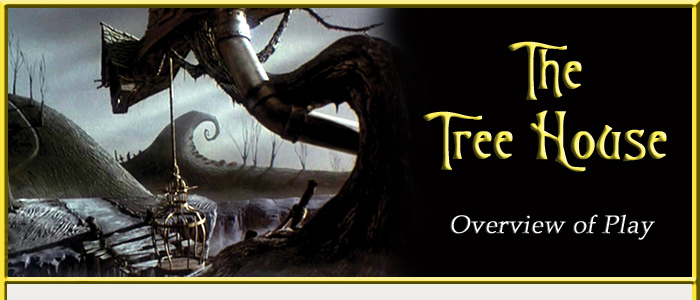|

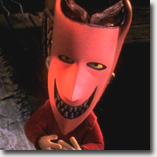 |
"I have the most devious mind in our gang, so I was elected to talk about the deviously simple Round Order! Also, this was the last thing left to talk about, so I didn't have a choice..." |
There are three phases in every Round, including the Start Phase (performed by all the players at the same time), the Player Phase (where each player takes a separate Player Turn), and the End Phase (performed by all the players at the same time).
START PHASE: The activities undertaken during the Start Phase are only done once per Round, not once during each player's turn. When all three activities are done in the following order, the Start Phase ends and the Player Phase begins.
Remove Day Counter: At the start of the game, there are 12 Day Counters in the center of the table that represent the 12 Days left until Christmas. The first thing you do during the Start Phase is pull one of these out of the center to show that a new Day (i.e. a new Round) has begun.
Place new Locales: During the first Round of the game, everyone flips their Starting Locale face up and draws their Starting Hand from their Main Deck (the number of cards drawn is indicated on each player's Starting Locale).
During later Rounds, the players don't draw their Starting Hands again. Instead, each player draws a random Locale from the top of his Locale Deck and places it face up on the right end or left end of his row of Locales (but not between any of his previously placed Locales).
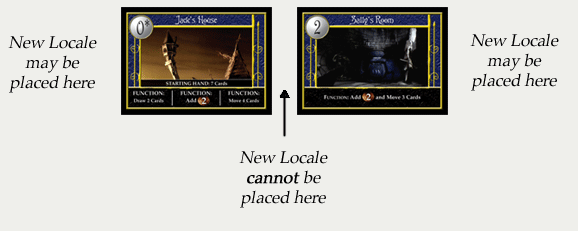
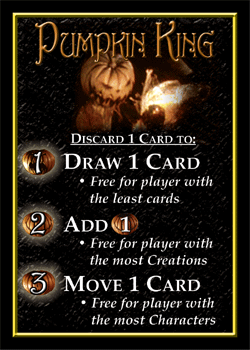 Pumpkin King Activity: At the start of the game, one player is randomly chosen to be the game's first Pumpkin King. During the Start Phase, the Pumpkin King chooses one of the three Pumpkin King activities listed on the Pumpkin King Card (see right). Each player (starting with the Pumpkin King) can then choose to discard a card from his hand in order to perform the chosen activity. Pumpkin King Activity: At the start of the game, one player is randomly chosen to be the game's first Pumpkin King. During the Start Phase, the Pumpkin King chooses one of the three Pumpkin King activities listed on the Pumpkin King Card (see right). Each player (starting with the Pumpkin King) can then choose to discard a card from his hand in order to perform the chosen activity.
As indicated on the Pumpkin King Card, one player can usually perform the chosen activity for free (in other words, without discarding a card). For example, if the Pumpkin King chooses the "Draw 1 Card" activity, then the player with the least number of cards in her hand gets to draw 1 card for free. If any players are tied for the least number of cards, then no one gets to draw 1 card for free.
The Pumpkin King should pick the activity that will benefit himself the most and his opponents the least. The Pumpkin King activity keeps the game interactive every Round of the game, even if the players aren't playing particularly aggressive decks. Of course, my decks are always very aggressive!
PLAYER PHASE: During the Player Phase, each player (starting with the Pumpkin King and continuing clockwise around the table) gets to perform one Player Turn.
During his turn, a player performs one Function at one of his Active Locales. He also gets to play as many cards as he likes, as long as he pays the cost for each card by removing a number of Pumpkin Points from his Pumpkin Points Card equal to the card's Scare Number (see below).
Perform 1 Function: Each turn, a player performs one Function (and only one Function) listed on one of his Active Locales. Remember that since a player's Starting Locale has a Scare Threshold of 0, the Starting Locale is always Active. The other Locales, however, only become Active when the combined Scare Numbers of the Characters present at those Locales are equal to or greater than the Locales' Scare Thresholds.
The Functions on the Locales generally fall into one of three categories:
Draw Cards: The player draws the specified number of cards from the top of her Main Deck into her hand. Performing a Function is the main way that players draw cards in this game, so they must be careful to choose their Functions wisely.
Add Pumpkin Points: 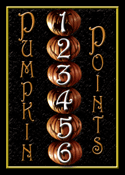 The player adds the number of Pumpkin Points listed in the Function's Pumpkin Symbol. Players use Pumpkin Points throughout the game to pay for Card Costs. To keep track of his Pumpkin Points, each player uses his Pumpkin Points Card (see right) by sliding a Pumpkin Points Counter (such as a glass bead or coin) up or down on his Pumpkin Points Card to record the number of Pumpkin Points added or removed. The player adds the number of Pumpkin Points listed in the Function's Pumpkin Symbol. Players use Pumpkin Points throughout the game to pay for Card Costs. To keep track of his Pumpkin Points, each player uses his Pumpkin Points Card (see right) by sliding a Pumpkin Points Counter (such as a glass bead or coin) up or down on his Pumpkin Points Card to record the number of Pumpkin Points added or removed.
Move Cards: The player spends Movement to move his Characters from one Locale to the next. Each Movement is used to move a single Character from one Locale to an adjacent Locale. Players can choose to split up their Movement however they wish. For example, if a Locale allows a player to "Move 3 Cards", the player can choose to move 3 different Characters once each, or the same Character three times, or one Character twice and another Character once. Players are never required to perform more of a Function than they wish, however, so a player could choose to move just one Character one time if she preferred.
Play Cards: Players can play as many cards as they like during their own Player Turns (but not during their opponents' turns unless the cards' text specifies otherwise). In order to play a card, a player must first pay its Card Cost by removing a number of Pumpkin Points from his Pumpkin Points Card equal to the card's Scare Number.
Each Character is placed below a Locale in the player's own Halloweentown. Each Creation is placed off the side, away from a player's Locales (although the Creations are still considered to be part of the player's Halloweentown). Most Surprises are discarded into the player's temporary Surprise Discard Pile as soon as their abilities take effect. Some Surprises specify that they remain on the table or Stack on a Character in order to increase that Character's Scare Number.
Players are not allowed to have duplicates of any cards in their own respective Halloweentowns (even at different Locales in their Halloweentowns). However, each player is allowed to have the same cards in his Halloweentown that are in his opponents' Halloweentowns.
END PHASE: The activities of the End Phase are performed in the following order, and are performed simultaneously by all the players.
Empty Pumpkin Points: Each player removes the Pumpkin Points Counter from his Pumpkin Points Card. Pumpkin Points do not accumulate from one Round to the next.
Reimburse Surprises: Each player gathers up his Surprise Discard Pile and places it in a neat stack on top of his regular Discard Pile. Each player may then draw a number of cards from the top of his Main Deck equal to the number of cards that were in his Surprise Discard Pile.
Discard down to 7 cards: Players can have as many cards in their hands as they want during the Player Phase. However, each player must discard down to 7 cards during the End Phase.
Recycle empty Main Decks: If any players have run out of cards in their Main Decks, they get to reshuffle their Discard Piles during the End Phase and place them face down to form new Main Decks.
Rotate Pumpkin King: The current Pumpkin King passes the Pumpkin King Card to the player on his left. If there are any Day Counters remaining in the center of the table, then the next Round begins with a new Start Phase. If there are no Days Counters left in the center of the table when the Pumpkin King Card rotates, then the game ends and each player tallies his or her Scare Points to determine the winner!
NEXT: Winning the Game
Back to Card Types
|
